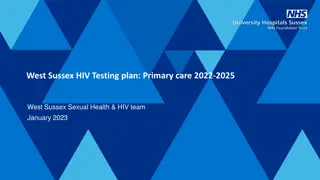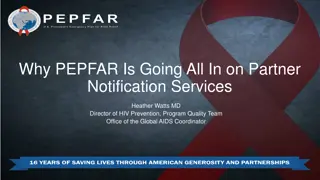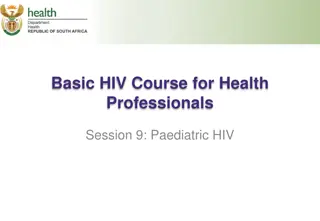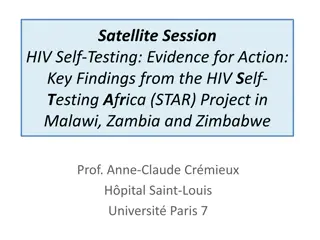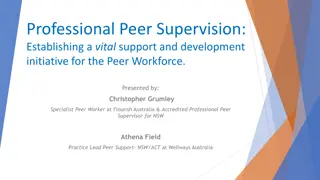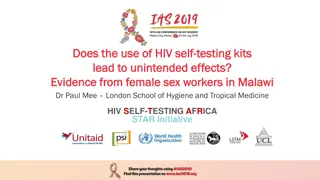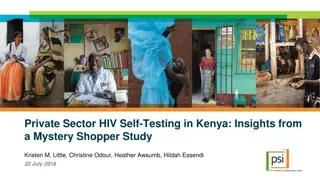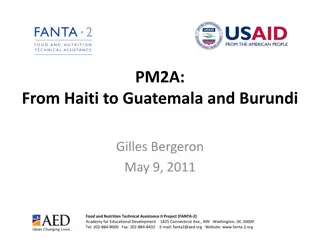Peer Mobilized HIV Self-Testing for Key Populations in Burundi
Implementing peer-mediated HIV self-testing has proven effective in increasing case detection and linkage to antiretroviral therapy among key populations in Burundi. This approach, led by LINKAGES project, has shown success in improving access to testing and treatment services, contributing to the HIV response in the country.
Download Presentation

Please find below an Image/Link to download the presentation.
The content on the website is provided AS IS for your information and personal use only. It may not be sold, licensed, or shared on other websites without obtaining consent from the author.If you encounter any issues during the download, it is possible that the publisher has removed the file from their server.
You are allowed to download the files provided on this website for personal or commercial use, subject to the condition that they are used lawfully. All files are the property of their respective owners.
The content on the website is provided AS IS for your information and personal use only. It may not be sold, licensed, or shared on other websites without obtaining consent from the author.
E N D
Presentation Transcript
Peer Peer- -mobilized HIV self mobilized HIV self- -testing increases case detection testing increases case detection and linkage to ART among key populations in Burundi and linkage to ART among key populations in Burundi Dismas Gashobotse, MD FHI 360/LINKAGES, Burundi @LINKAGESproject Share your thoughts on this presentation with #IAS2019 #IAS2019 Share your thoughts on this presentation with
Background Background LINKAGES is a global project funded by USAID/PEPFAR working in 30 countries to address the HIV prevention, care, and treatment needs of key populations (KPs) female sex workers (FSWs), men who have sex with men (MSM), transgender people, and people who inject drugs LINKAGES has been working in Burundi since August 2016; currently in six provinces
HIVST background in Burundi HIVST background in Burundi LINKAGES began implementing directly assisted, peer-mediated HIV self-testing (HIVST) in June 2018 in three provinces Extended HIVST activities to three additional provinces in December 2018 By the end of March 2019: 2321 test kits have been used 389 kits have been reactive 326 confirmed positive (14% case-finding) 312 initiated on ART (96% ART initiation)
Creating demand Creating demand HIVST adopted in the 2016 Burundi National Guidelines Risk assessment tool developed KP community consultations held Peers and health care providers trained to offer and assist with HIVST Sensitization workshops held targeting MOH officials, local administration, and health care providers HIVST launched by MOH for 2018 World AIDS Day Video demonstrating how to use Oraquick produced in the local language Evaluation conducted after one month of implementation to identify and address gaps
Community approach for HIVST Community approach for HIVST Peer-facilitated testing Peer outreach worker provides test kit Test reactive: Referral to DIC or HTC services for confirmatory test Linked to Care and Treatment services R E S U L T S Private testing at preferred location Clients reached through regular outreach activities Uptake of HIV self- testing using Ora Quick Private testing at DIC Continued engagement in HIV prevention and link to PrEP, VMCC as appropriate Drop in center based testing Test nonreactive: Advise for re- test in 3 months or refer for prevention services DIC staff- facilitated testing
FSW HIVST cascade (June 2018 to March 2019) FSW HIVST cascade (June 2018 to March 2019) 1919 1919 14.3% 14.3% 16.7 16.7% 85 85% 98% 98% 321 321 272 272 266 266 Used Used Reactive Reactive Confirmed Confirmed Linked to ART Linked to ART FSWs FSWs
MSM MSM HIVST cascade (June 2018 to March 2019) HIVST cascade (June 2018 to March 2019) 402 402 13.4 13.4% 16.9 16.9% 79.4 79.4% 85 85% 68 68 54 54 46 46 Kits Used Kits Used Reactive Reactive Confirmed HIV+ Confirmed HIV+ Linked to ART Linked to ART MSM MSM
Contribution of HIVST to case Contribution of HIVST to case- -finding among FSW finding among FSW FSW case-finding by HIV testing modality (June 2018-March 2019) HIVST contribution to all FSW case-finding (June 2018 to March 2019) 8000 15% 14% 22% 5912 6000 DIC/ Facility Case detection rate Number of FSW 10% 10% 4755 EPOA 49% 4000 Mobile 6% 6% HIV Self test 5% 1919 1626 2000 21% 608 272 267 99 0 0% DIC/ Facility EPOA Mobile HIV Self test 8% Tested Tested positive Case detection (%)
Contribution of HIVST to case Contribution of HIVST to case- -finding among MSM finding among MSM MSM case-finding by HIV testing modality (June 2018-March 2019) HIVST contribution to all MSM case-finding (June 2018 to March 2019) 3% 2000 20% 8% 1530 Case detection rate (%) 1500 15% DIC/facility 14% Number of MSM 38% 16% 13% HIVST 1000 10% Index testing 549 502 Mobile 500 5% 5% 213 201 3% 3% EPOA 70 64 29 15 6 0 0% 35% DIC/facility EPOA Mobile Index testing HIVST Tested Tested positive Case detection (%)
HIVST uptake trend (June 2018 to March 2019) HIVST uptake trend (June 2018 to March 2019) Saturation of PE networks 120 20% 18% 17% 16% 18% 97 100 16% 16% % case-finding rate 14% 80 Number of KPs 14% 66 13% 12% 64 60 10% 9% 47 8% 40 6% 25 5% 17 4% 20 10 2% 2 0 0% Quarter 3 FY18 Quarter 4 FY18 Quarter 1 FY19 Quarter 2 FY19 Confirmed positive FSWs Confirmed positive MSM Case-finding rate FSWs Case-finding rate MSM
HIVST confirmatory results against reactive trend HIVST confirmatory results against reactive trend (June 2018 to March 2019) (June 2018 to March 2019) 140 120% % of confirmed reactive cases 117 120 100% 100% 91% 90% 83% 97 89% 100 83% 80% Number of KPs 76% 68% 73 80 72 66 64 60% 59 60 45 40% 40 30 25 25 17 20% 20 11 10 2 2 0 0% Quarter 3 FY18 Quarter 4 FY18 Quarter 1 FY19 Quarter 2 FY19 Reactive Test FSWs Confirmed positive FSWs Reactive Test MSM Confirmed positive MSM Percent of confirmed against reactive FSWs Percent of confirmed against reactive MSM
Implementation challenges Implementation challenges Gaps between reactive and confirmatory results due to: PE difficulties interpreting results Lack of transportation to facility Discomfort accessing facility-based services Saturation of PE networks Low linkage rate to ART among MSM
Solutions to challenges Solutions to challenges Enhance capacity of PEs to interpret OraQuick results Offer transportation reimbursement for those who present for confirmatory testing Offer additional options for links to confirmatory testing and ART initiation Access to private facilities Community-based provision of services Train another team of PEs on HIVST to access new networks
Conclusions Conclusions HIVST improves uptake of HIV testing among KPs who rarely or never tested HIVST increases diagnosis of FSWs and MSM living with HIV and links them to treatment LINKAGES is scaling up HIVST to other populations (i.e., FSWs partners) and new provinces More widespread implementation of HIVST with high-risk populations could accelerate progress toward 95-95-95 goals







